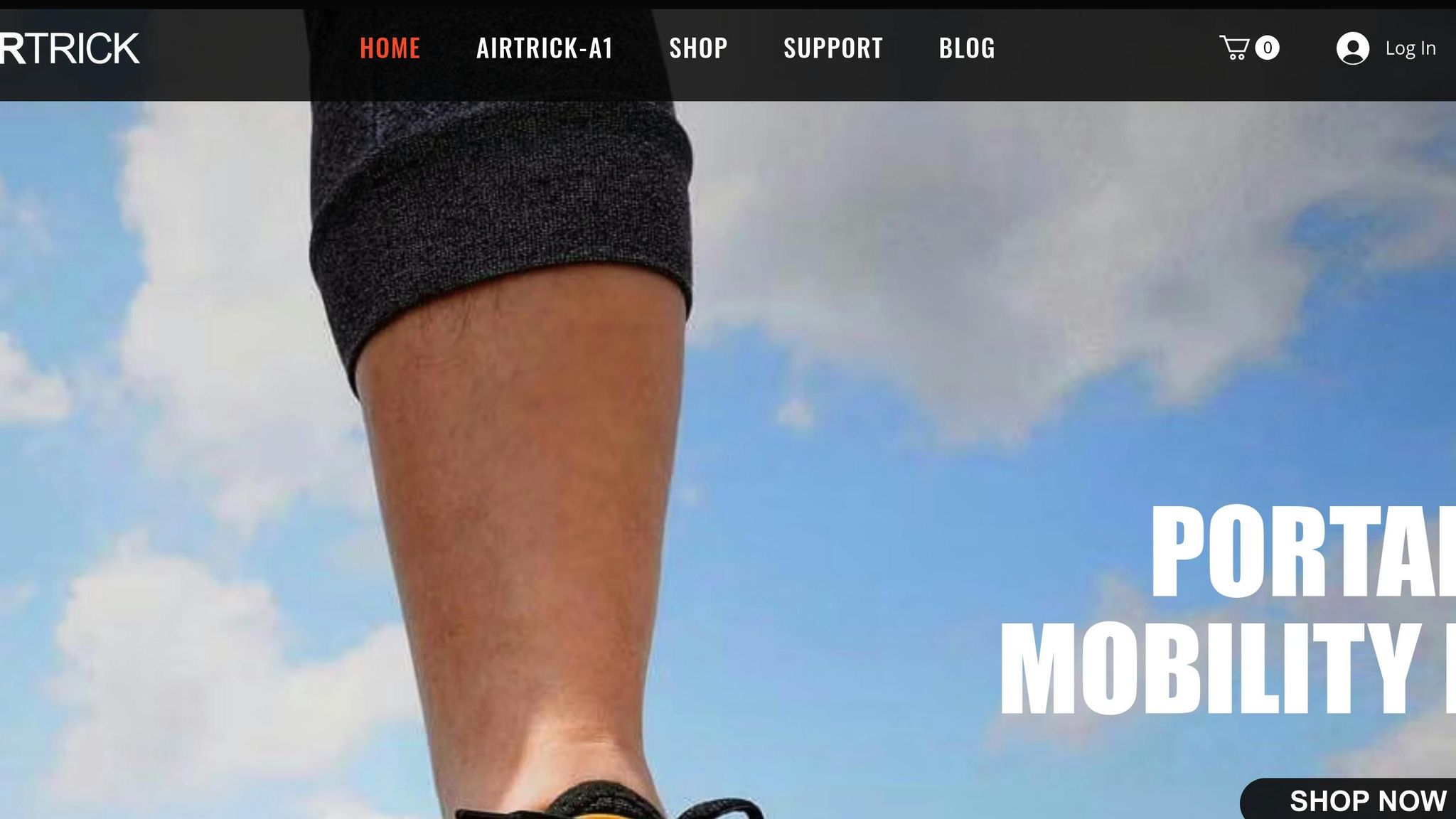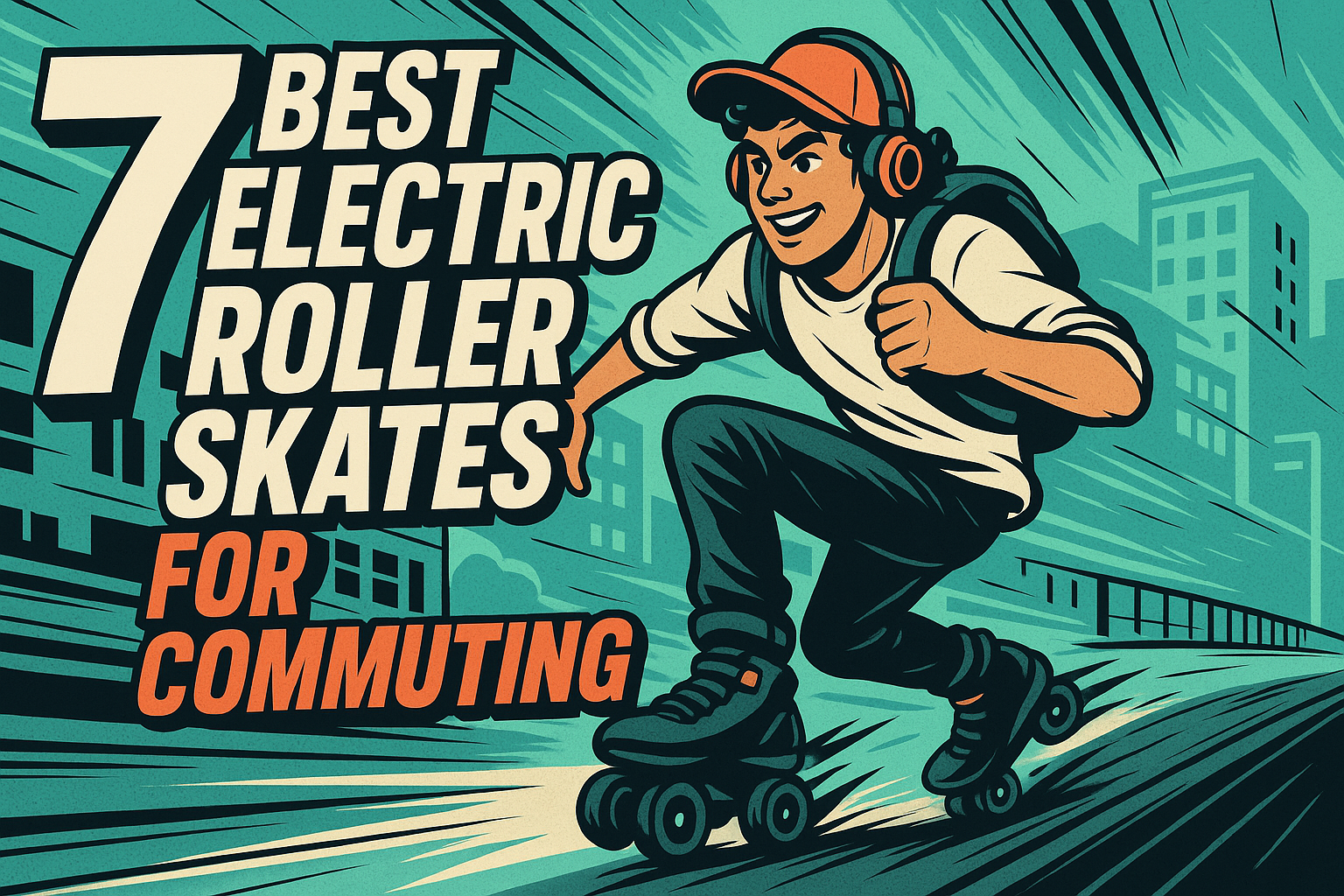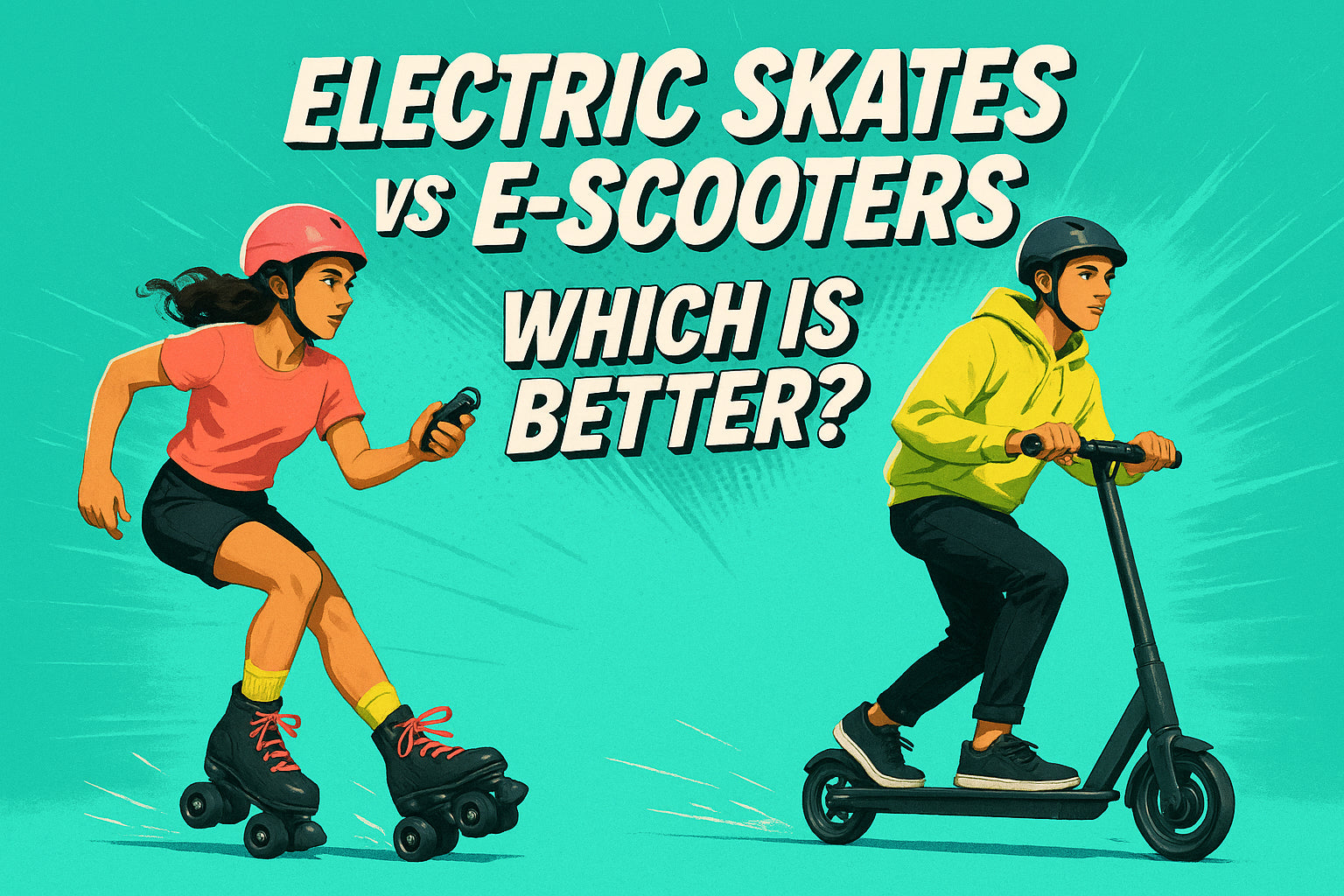Electric skates are transforming urban commutes by offering a compact, energy-efficient, and eco-friendly way to travel. They combine convenience, speed, and fun, making them a popular choice for short trips and recreational use. With options ranging from $500 to $1,000, choosing the right pair requires balancing factors like battery life, speed, portability, and durability.
Key Points to Consider:
- Battery Life & Range: Most models cover 6-35 miles per charge. Choose based on your daily commute distance.
- Speed & Motor Power: Speeds range from 10-25 mph. Look for motors suited to your terrain and weight.
- Portability: Lightweight skates (8-20 lbs) are easier to carry but may trade off battery capacity.
- Durability: High-quality materials like carbon fiber or aluminum ensure longevity.
- Comfort: Adjustable sizing, ankle support, and cushioned footbeds improve usability.
Quick Comparison of Two Popular Models:
- Wheelfeet Electric Skates: 15 mph speed, 9-mile range, lightweight, regenerative braking.
- Airtrick Electric Skates: 13 mph speed, 7.5-mile range, durable aluminum build, dual-mode operation.
Before purchasing, check local laws, warranty options, and safety features to ensure the skates align with your needs and regulations. Proper maintenance and safe riding practices will keep your skates in top condition while enhancing your riding experience.
Electric Skates Basics
What Are Electric Skates?
Electric skates take the classic roller or inline skates and give them a modern twist by incorporating rechargeable lithium-ion batteries and motor systems, such as hub motors or belt drives. Instead of relying on manual effort to move, these skates are powered by electromagnetic energy and controlled using handheld remotes, foot sensors, or even smartphone apps. They can reach speeds between 10 and 25 mph, making them a practical choice for short commutes or leisurely rides .
These skates are particularly useful for medium-distance travel. For instance, Wheelfeet electric skates can cover up to 9 miles on a single charge, making them ideal for daily commutes or quick errands .
In terms of design, electric skates cater to different preferences. Whether you like the stability of traditional four-wheel roller skates or the sleek, streamlined feel of inline skates, there’s an electric version to match your style.
But electric skates are more than just a cool gadget - they offer real benefits for day-to-day mobility.
Main Benefits of Electric Skates
One of the standout features of electric skates is their portability and ease of use in urban settings. They make it simple to transition indoors, navigate sidewalks, and weave through crowded areas without hassle.
Another key advantage is their hybrid functionality. Most electric skates allow you to switch between electric and manual modes. This means if your battery runs out or you’re in the mood for a workout, you can skate manually without motor assistance. This versatility makes them suitable for both commuting and recreational use.
Cost is another factor that adds to their appeal. Entry-level models start at around $500, while premium options can go over $1,000. For example, Wheelfeet electric skates are often available for $599 during sales (regularly priced at $699) . While the upfront cost might seem high, they can help save on ongoing transportation or fuel expenses over time.
On top of that, electric skates are an eco-friendly choice. They produce zero direct emissions and consume far less energy than traditional vehicles, making them a greener option for short-distance travel.
For those who enjoy skating for fun or fitness, electric skates strike a perfect balance. They let you cover longer distances without tiring out too quickly while still offering the option to switch to manual mode for a more active workout. Whether you’re commuting or just enjoying the ride, they bring a mix of practicality and enjoyment to your routine.
AIRTRICK E-SKATES: Not Great for Inline Skaters

Important Factors When Choosing Electric Skates
Picking the right electric skates is all about finding a pair that fits your lifestyle and transportation needs. Here’s a breakdown of the key factors to consider.
Battery Life and Range
Battery life is a make-or-break feature, especially for daily commutes. The distance you can travel on a single charge depends on the battery capacity, and most electric skates offer a range between 6 and 35 miles. For example, Wheelfeet electric skates provide up to 9 miles per charge, which works well for shorter trips.
Lithium-ion batteries are widely regarded as the best option. They typically last for 500 to 1,000 charge cycles and strike a good balance between durability, safety, and cost compared to alternatives like LiPo or LiFePO4 batteries. Keep in mind that your riding habits - like frequent acceleration, climbing hills, or maintaining high speeds - can drain the battery faster. Even factors like rider weight play a role, with heavier riders often experiencing reduced range.
To get the most out of your battery, practice good charging habits. Once you’ve figured out your range needs, it’s time to think about speed and motor power.
Speed and Motor Power
Electric skates usually hit speeds between 10 and 25 mph, but most models top out around 15 mph to balance speed with safety. For urban commuting, a range of 12–15 mph is typically ideal.
Motor power, measured in watts, determines both the maximum speed and the skate’s ability to handle hills or carry heavier riders. The type of motor also matters. Hub motors, built directly into the wheels, are quieter and sleeker, while belt-drive systems provide more torque and are better for steep inclines. Think about your usual routes and terrain to decide which setup suits you best.
Weight and Portability
Weight can make or break the practicality of electric skates, especially if you’re carrying them on public transportation or up stairs. Most models weigh between 8 and 20 pounds per pair. If you’re commuting in a city, lightweight designs like those from Wheelfeet are a smart choice since they’re easier to carry around.
That said, lighter skates might sacrifice some battery capacity or speed. If you prioritize stability and durability over portability, a slightly heavier model could be worth considering.
Durability and Build Quality
Durability is essential when you’re using electric skates every day. The materials used for the deck and frame significantly impact both longevity and ride quality. Maple wood, for instance, is tough and absorbs shocks well, making it a great choice for beginners. Bamboo is lighter and flexible while still offering decent shock absorption. For the best combination of strength and lightness, carbon fiber is the go-to option, though it comes with a higher price tag.
Pay attention to the trucks, too. Forged trucks are sturdier than cast ones and stand up better to the wear and tear of regular use. Also, look for skates with enclosed electronics to protect against water, dust, and impacts - especially if you’ll be riding in unpredictable weather.
Comfort and Fit
Comfort is crucial for daily use. Adjustable sizing features can accommodate different foot sizes or sock thicknesses, ensuring a snug fit. Look for skates with ankle support, cushioned footbeds, and breathable materials.
The boot design should evenly distribute pressure across your foot to avoid discomfort. Closure systems like BOA dials, laces, Velcro straps, or buckles can also affect how easy the skates are to put on and take off.
Ergonomics matter, too. Features like arch support, a secure heel lock, and a roomy toe box can make longer rides more enjoyable. If possible, try on different models or read reviews from other commuters to find a pair that feels right for you.
Wheelfeet Electric Skate Models Comparison

When it comes to electric skates, Wheelfeet offers two standout models that cater to different needs. Each model brings its own strengths, helping you choose the one that fits your commuting style best.
Wheelfeet Electric Roller Skates
The Wheelfeet Electric Roller Skates are designed with urban commuters in mind, prioritizing speed and convenience. With a top speed of 15 mph and a 9-mile range per charge, they’re perfect for longer commutes where every minute counts.
One of their standout features is the regenerative braking system, which not only ensures smooth and controlled stops but also recharges the battery as you skate. These skates are 70% lighter than most electric scooters, making them easy to carry around - a huge plus for those navigating city life.
Additional features include a wireless controller for effortless operation and adjustable bindings that accommodate shoe sizes 6-13 US (38-47 EU). With a stellar 5.0/5 rating from 12 reviews, users frequently highlight their practicality and fun factor. As Peter Watson shared:
"I was a bit hesitant from the beginning but now I'm using them almost daily for short distances across the city. They're not only convenient but also great fun!"
Airtrick Electric Roller Skates
The Airtrick Electric Roller Skates take a different approach, prioritizing durability and versatility. They reach a top speed of 13 mph and offer a range of 12 km (about 7.5 miles), making them a solid choice for those who value reliability over speed.
What sets this model apart is its dual-mode operation, allowing you to switch between electric and manual skating. This feature is especially handy when the battery is low or if you’re looking to squeeze in some exercise. Built with durable aluminum construction, these skates are made to last, appealing to riders who favor longevity over portability.
Feature Comparison Table
Here’s a quick look at how the two models stack up:
| Feature | Wheelfeet Electric Roller Skates | Airtrick Electric Roller Skates |
|---|---|---|
| Top Speed | 15 mph | 13 mph |
| Range | 9 miles | 12 km (7.5 miles) |
| Braking System | Regenerative Braking | Not specified |
| Construction | Lightweight & Compact | Durable Aluminum |
| Special Features | Wireless controller, 70% lighter than e-scooters | Dual-mode operation |
| Sale Price | $599.00 | $599.00 |
| Regular Price | $699.00 | $699.00 |
Both models are priced in the mid-range category for electric skates, typically between $400 and $600. If speed and portability are your top priorities, the Wheelfeet model is the way to go. On the other hand, if you’re looking for durability and the option to skate manually, the Airtrick model may be the better fit.
sbb-itb-bf837b9
Tips for Choosing the Right Electric Skates
Finding the perfect pair of electric skates means matching their features to your lifestyle and understanding how and where you plan to use them. It’s not just about performance - it’s about ensuring they fit your needs and comply with local regulations.
Match Features to Your Lifestyle
Think about how you'll use your skates. For daily commutes, battery life and portability are crucial. Choose skates that can comfortably cover your commute distance with some extra range for peace of mind. Lightweight models are easier to carry, especially if you need to hop on public transportation. Features like LED lights and wider wheels can also make a big difference, improving visibility and offering better stability on uneven roads.
If you’re skating for fun, prioritize performance. Speed, acceleration, and agility are key for recreational use. Skates that are responsive and easy to maneuver will let you enjoy carving turns and exploring at your own pace.
Keep in mind the balance between weight and range. Lighter skates are easier to carry but might not go as far on a single charge. Heavier models often provide more power and longer range but can be less convenient to transport. Similarly, larger wheels handle rough surfaces better, while smaller wheels excel on smooth, city streets.
Finally, don’t overlook local laws - make sure the skates you pick are legal to use in your area.
Check Local Laws and Regulations
Electric skate laws vary widely across the U.S., and riding without following local rules can lead to fines or even having your skates confiscated. Before buying, take time to research the regulations where you live.
Here’s a quick look at some state-specific rules:
- California: You can ride on bike paths and roads with speed limits of 35 mph or less. Helmets are mandatory, and there’s a 15 mph speed limit. Lights are required for night riding.
- Florida: Skates are banned on public roads and sidewalks but allowed in bike lanes. Riders must be 16 or older, and minors need helmets.
- Michigan: Legal on roads with speed limits under 25 mph, with a maximum skating speed of 25 mph. Riders must be at least 12 years old, and helmets are required for those under 19.
- Texas: Electric skates are treated as motor vehicles. You can ride them on roads with speed limits of 35 mph or less, as well as some bike lanes and sidewalks.
- New York: Riding is prohibited on public roads, sidewalks, and bike lanes. They’re only allowed on private property.
For the most accurate information, check your local government’s website or contact the transportation department directly.
Once you’ve ensured your skates are legal and suited to your needs, it’s time to think about protecting your investment.
Review Warranty and Support Options
A solid warranty and good customer support are essential when buying electric skates.
Most warranties cover defects in materials and workmanship, offering repairs or replacements. However, they typically don’t cover damage caused by accidents, misuse, or normal wear and tear. Warranty periods vary, with many manufacturers offering one year of coverage.
Pay attention to what’s included. Structural components like frames and motor housings often have more comprehensive coverage, whereas parts like wheels or belts may only have limited protection. It’s also worth checking the manufacturer’s reputation for customer service and the availability of spare parts for routine maintenance.
Understand the warranty claim process. This includes knowing what documentation you’ll need, whether you’ll have to cover shipping costs, and how long claims typically take. Reading customer reviews can also give you a sense of how well a company handles warranty issues.
Maintenance and Safety Guidelines
Taking care of your electric skates and following safe riding practices can help reduce wear, prevent accidents, and save you from expensive repairs down the line. A little effort in upkeep goes a long way toward ensuring a smooth and reliable commute.
Basic Maintenance Steps
Keep your skates clean. After every few rides, use a soft brush to remove dirt, grip gum for the grip tape, and a dry cloth to wipe down the motors. Avoid using water or liquid cleaners on electrical components, as these can cause damage.
Take care of the battery. Charge it after every use and store it in a dry, room-temperature space, away from direct heat sources. If you’re not planning to use your skates for a while, make sure to charge the battery at least once a month to prevent it from completely draining.
Inspect components regularly. Check the deck for cracks, the wheels for flat spots or debris, and the electrical connections for signs of fraying or corrosion. Tighten all screws and bolts as needed. These simple checks can help you catch potential issues before they become bigger problems.
Store them properly. Keep your skates in a cool, dry place. If storing them for an extended period, rotate the wheels occasionally to avoid flat spots and keep the bearings from seizing. Some handy tools to have on hand include screwdrivers, cleaning agents, a toothbrush for detailed cleaning, cotton cloths, and bearing oil for wheel maintenance.
While regular maintenance keeps your skates in top shape, don’t forget that safety is just as important.
Safety Gear and Riding Practices
Always wear protective gear, including a helmet, knee pads, and elbow pads, to minimize the risk of injury. To stay visible, especially in low-light conditions, consider wearing reflective clothing or adding reflective accessories to your gear.
Ride smart by maintaining steady speeds and using smooth acceleration and braking. Stay alert and aware of your surroundings to avoid unexpected hazards. Defensive riding is key to a safe commute. Also, steer clear of unfavorable weather conditions like rain or wet surfaces, as these can increase the risk of slipping and may affect your skates’ performance.
Now that you’ve got safety and maintenance covered, let’s talk about getting the most out of your battery.
How to Maximize Battery Performance
Develop good charging habits. Always use the charger that’s designed for your skates. Generic chargers can damage the battery or pose safety risks. Be sure to unplug the charger once the battery reaches 100% to avoid overcharging.
Store your battery wisely. If you’re not riding daily, keep the battery at around 40–50% charge. For long-term storage, remove the battery and store it in a cool, dry place, away from temperature fluctuations.
Adjust your riding style. Rapid acceleration and steep hills drain the battery quickly. Instead, maintain steady speeds and avoid rough terrain when possible. Keep your load light, as heavier weights can reduce your range. If your skates feature regenerative braking, use it to recover some energy while stopping.
Don’t skip regular maintenance. Clean the deck and hardware with mild soap and water, but be cautious around electrical components. Periodically check and tighten connections to prevent power loss. Also, keep your firmware updated - manufacturers often release updates that improve battery efficiency.
Finally, be mindful of temperature. Exposing your skates to excessive heat or direct sunlight can permanently damage the battery cells. Always store them in a cool, shaded area to maintain optimal performance.
Conclusion: Choose Electric Skates That Fit Your Daily Needs
Selecting the right electric skates is all about aligning their features with how you plan to use them. Whether you're commuting a few miles to work every day or just enjoying weekend rides around the neighborhood, your specific needs should guide your decision.
Commuters and recreational riders often have different priorities. For daily commutes, focus on battery range and durability. A model with a range of 15+ miles and a solid build will outlast one that prioritizes speed but only manages 8 miles per charge. On the other hand, if you're riding for fun, agility and quick acceleration might matter more - perfect for tricks or zipping through the park.
Budget is another key factor, but think beyond the upfront cost. Electric skates range from $300 to over $1,500, and spending a bit more on quality components - like reliable brakes, sturdy materials, and efficient battery management - can save you money on repairs later. Portability is equally important if you'll be carrying your skates often. Lightweight models (10-15 pounds) are easier to handle, while heavier ones (20+ pounds) may feel cumbersome, especially if you're navigating public transport or stairs.
For dependable options, consider models like those mentioned earlier. Brands such as Wheelfeet offer a balance of speed, range, and practical features, making them a solid choice for urban mobility.
"They make my daily commute a breeze, and I love how customizable they are with the remote control. Plus, they're so much fun to ride! Highly recommend." - Jane M.
Lastly, don't overlook practicalities like local regulations and warranty coverage before committing to a purchase.
The right electric skates should fit seamlessly into your lifestyle, making your rides feel effortless and enjoyable. Take the time to assess your needs and find the perfect match.
FAQs
What should I consider when choosing between lightweight and durable electric skates for daily commuting?
When choosing between lightweight and durable electric skates for your daily commute, it all comes down to what matters most to you: portability or sturdiness.
Lightweight skates, which often weigh just a few pounds, are ideal if your commute involves a mix of walking or hopping on public transit. They’re easy to carry, store, and perfect for navigating busy urban settings where convenience is everything. On the flip side, durable skates are built to last. While they’re heavier, they can handle regular use and tougher terrains, making them a solid choice for those who value reliability and performance over time.
If your routine includes carrying skates frequently or squeezing them into tight spaces, a lightweight option will likely suit you best. But if you’re dealing with rougher paths or need something that can stand up to daily wear and tear, durability should take priority. Think about your commute, the conditions you’ll face, and your personal habits to find the right fit for your needs.
How can I make sure my electric skates follow local laws before buying them?
Staying Within the Law: Electric Skates and Local Regulations
If you're planning to use electric skates in the United States, it's crucial to understand the local laws that apply in your area. Regulations can differ widely from state to state - and even city to city. For instance, some places might enforce speed limits, mandate helmet use, or restrict where you can ride, like banning skating on sidewalks or limiting access to bike lanes.
Before making a purchase, take a moment to review your local transportation rules. A quick look at your city’s official website or a call to a local authority can save you from unexpected fines or legal headaches. Plus, it ensures your skates meet the safety and legal standards required for your area.
How can I keep the battery of my electric skates in good condition over time?
To keep your electric skates' battery performing well, store it at around 50% charge if you plan to set them aside for an extended period. Avoid letting the battery completely drain or overcharging it, as both can reduce its lifespan. During regular use, aim to keep the charge level between 10% and 90%.
Store your skates in a cool, dry spot, away from extreme heat, cold, or direct sunlight - excessive heat, in particular, can harm the battery. Recharge the battery before it fully depletes, and steer clear of fast-charging methods, which can put unnecessary strain on it. These simple habits will help keep your skates dependable and ready to roll whenever you are.




Leave a comment
All comments are moderated before being published.
This site is protected by hCaptcha and the hCaptcha Privacy Policy and Terms of Service apply.